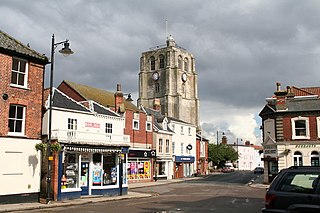
Beccles is a market town and civil parish in the English county of Suffolk. The town is shown on the milestone as 109 miles (175 km) from London via the A145 and A12 roads, 98 miles (158 km) north-east of London as the crow flies, 16 miles (26 km) south-east of Norwich and 33 miles (53 km) north-northeast of the county town of Ipswich. Nearby towns include Lowestoft to the east and Great Yarmouth to the north-east. The town lies on the River Waveney on the edge of The Broads National Park.
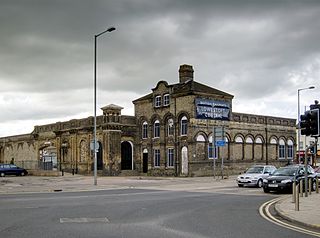
Lowestoft railway station serves the town of Lowestoft, Suffolk, and is the eastern terminus of the East Suffolk Line from Ipswich and is one of two eastern termini of the Wherry Lines from Norwich. Lowestoft is 23 miles 41 chains (37.8 km) down the line from Norwich and 48 miles 75 chains (78.8 km) measured from Ipswich; and is the easternmost station on the National Rail network in the United Kingdom.

Beccles railway station is on the East Suffolk Line in the east of England, serving the town of Beccles, Suffolk. It is 40 miles 34 chains (65.1 km) down the line from Ipswich and 109 miles 11 chains (175.6 km) measured from London Liverpool Street; it is situated between Brampton and Oulton Broad South stations. Its three-letter station code is BCC.

Ellingham is a civil parish in Norfolk, England. It covers an area of 5.61 km2 (2.17 sq mi) and had a population of 532 in 238 households at the 2001 census, the population increasing to 554 in 248 households at the 2011 census. It lies approximately 2 miles (3.2 km) from Bungay and 4 miles (6.4 km) from Beccles. Within 17 miles (27 km) are Norwich, Diss and, on the North Sea coast, with associated beaches and port, Great Yarmouth. A large percentage of the housing and human population is in the east, Kirby Row the largest nucleated village, which is shared with Kirby Cane, the civil parish to the east.

Diss railway station is on the Great Eastern Main Line in the East of England, serving the town of Diss, Norfolk. It is 94 miles 43 chains (152.1 km) down the line from London Liverpool Street and is situated between Stowmarket to the south and Norwich to the north. It is approximately 20 miles (32 km) south of Norwich. Its three-letter station code is DIS.

The Waveney Valley line was a branch line running from Tivetshall in Norfolk to Beccles in Suffolk connecting the Great Eastern Main Line at Tivetshall with the East Suffolk line at Beccles. It provided services to Norwich, Great Yarmouth, Lowestoft, Ipswich and many other smaller towns in Suffolk with additional services to London. It was named after the River Waveney which follows a similar route.

Bungay railway station was located on the now disused Waveney Valley Line which ran between Tivetshall and Beccles. The station was closed in 1953 and the buildings eventually demolished to make way for the A143 road. It was one of two stations in Suffolk on the line, which curved across the county boundary then back into Norfolk.

Lowestoft North railway station was in Lowestoft, England. It closed in 1970.

Pulham Market was a railway station on the Waveney Valley Line in Norfolk, England. It was closed for passengers in 1953.
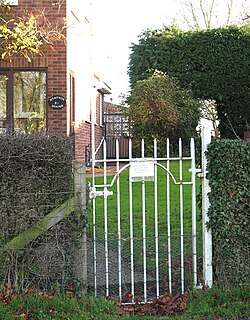
Pulham St Mary was a station in Pulham St Mary, Norfolk on the Waveney Valley Line which is now closed. The station has been demolished.

Harleston was a railway station in Harleston, Norfolk, on the Waveney Valley Line. It was an early post-war closure; passenger services on this line were withdrawn in 1953 with goods trains lasting until the complete closure of the line in 1966.

Homersfield was a railway station which served the village of Homersfield in Suffolk, England, although the station was located in Alburgh, across the county boundary in Norfolk. The station was part of the Waveney Valley Line.
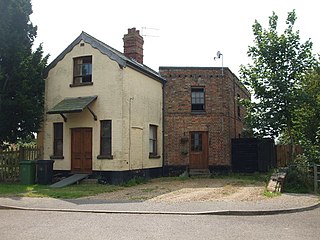
Earsham was a railway station in Earsham, Norfolk, on the Waveney Valley Line, connecting Beccles with the Great Eastern Main Line which opened in 1860, and closed to passengers in 1953, and to goods services in 1960. It was not demolished, but lay derelict for many years before being converted into housing. The platform remains as do many original features.

Yarmouth South Town, sometimes known as Yarmouth Southtown, was a railway station in Great Yarmouth, England, that is now closed. It was one of three major stations in the town, the others being Yarmouth Vauxhall and Yarmouth Beach, of which only Yarmouth Vauxhall now remains.

Ellingham is a former railway station in Ellingham, Norfolk. It was opened in 1863 as part of the Waveney Valley Line between Tivetshall and Beccles, Suffolk. It was closed to passengers in 1953 and closed fully on 19 April 1965, when the last goods train called there. The station still stands much altered

Redenhall was a station in the small hamlet of Redenhall, Norfolk. It was opened in 1861 as part of the Waveney Valley Line between Tivetshall and Beccles and closed in 1866. It was close to the settlement of Harleston.

Ditchingham was a railway station in Ditchingham, Norfolk on the Waveney Valley Line. Opened on 2 March 1863, it closed to passengers along with the rest of the line in 1953.
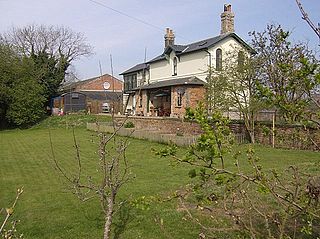
Geldeston was a station in Geldeston, Norfolk – a station on the Waveney Valley Line. It was opened in the early 1860s, and closed to passengers nearly a century later in 1953. It was the penultimate station on the line, and the last in Norfolk as the line crossed the border into Suffolk before the junction station of Beccles. The station still exists today and can easily be found in Geldeston.
Wortwell was a station in the small hamlet of Wortwell, Norfolk. It was opened in 1855, as part of the Waveney Valley Line between Tivetshall and Beccles, and closed in 1878.
The East Suffolk line is a railway in East Anglia with a long history.


















